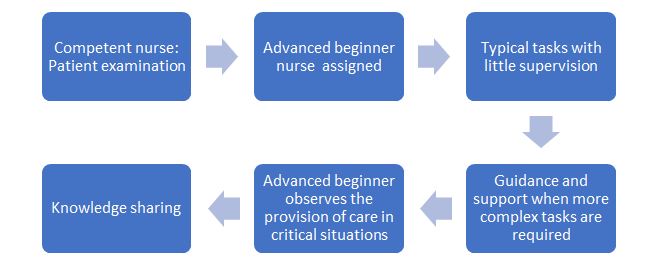Benner’s novice to expert model is a valuable framework for nurses enabling them to understand the significant challenges, needs, and potential of growth of practitioners at different stages of their professional development. The model consists of the following stages: novice, advanced beginner, competent, proficient, and expert (Murray et al., 2019). There is no particular periodization as each person may move at their own pace from one stage to another, excluding the first stages. An advanced beginner is typically a nurse graduate, having a sufficient scope of knowledge and skills to become a full member of the clinical staff. I am currently in the position of an advanced beginner as I have certain experience in the clinical setting due to my volunteering, clinical placement during training, and working experience.
As for the students described in the case, this practitioner is transitioning between a novice and advanced beginner as there are still two weeks to finish studies. At this stage, nurses have sufficient knowledge to complete diverse tasks, but in many cases, they need quite close supervision (Ozdemir, 2019). The most severe challenge new advanced beginners face is related to the decision-making process. At the initial stage of their practice, they will have to make diverse decisions in rather critical (or acute) cases, which is often associated with stress. Mentors help advanced beginners (or a person at any phase of the continuum) to address the issues they face, and the latter become more confident (Sterner et al., 2021). Mentors are more experienced practitioners who supervise less professional peers helping them in critical situations, sharing experience, and providing support.
Sue is in such a position of a mentor as she helps the nurse, supervising and training. The patient is still in the second stage of delivery, so the competence of the advanced beginner is sufficient to address the needs of the patient. However, due to the complexity (gestational diabetes) of the patient health status, the advanced beginner may need assistance. At that, taking vital signs and monitoring the patient’s state, as well as the provision of psychologic support, can be easily implemented by the nurse student. In case of an emergency and during the next stage of delivery, the student nurse will notify Sue. Sue will not assign the student to provide care to the patients with diabetes (she has had for her entire life) as this patient needs more skilled care. Being at the thirst stage of Benner’s continuum (competent), Sue has the necessary experience and skills to ensure the delivery of quality care to the patient.
Based on the provided scenario, it is possible to develop a personalized nursing model for the two patients. The model for a no-complexity patient can be presented in the form of a concept map (see Figure 1). The model consists of six phases: patient check, assigning advanced beginner, little to no supervision, guidance and support, care provision, and knowledge sharing. During the first stage, the competent nurse examines the patient’s records, vital signs, and identifies their health status. If no complex health conditions are present, the competent nurse (mentor) assigns an advanced beginner. The mentor discusses the patient’s needs and necessary clinical procedures to be conducted.

The third phase is characterized by little to no supervision as the advanced beginner can implement all the necessary tasks. If or when more complex procedures are needed, the mentor closely supervises the advanced beginner. For instance, in the case of the patient with gestational diabetes, the third phase starts with the end of the second stage of delivery. When the delivery process intensifies, the mentor closely supervises the implementation of typical procedures. The fifth stage of the model implies a complete involvement of the competent nurse in the process of care provision. This professional conducts all tasks at this stage while the advanced beginner observes. At the final stage, the two practitioners may discuss this experience with a focus on challenges, critical situations, errors (if any), and areas to improve. Notably, the fifth stage may be skipped if no critical situation occurs (which is not the case with the delivery process).
The model for the patient who has had diabetes for her entire life is similar to the one considered above but has five stages only (see Figure 2). Since the patient has a health status requiring more advanced care (with close supervision of vital signs and the entire delivery process), the advanced beginner cannot complete any tasks without the mentor’s supervision. Hence, the third stage is skipped, leaving a five-phase model for complexity patients.

In conclusion, the new frameworks based on Benner’s model can be used with patients having different health statuses. Notably, the final stage of the proposed models implies knowledge sharing that is instrumental in a smoother transition to a higher stage of proficiency-based on Benner’s paradigm. Although it may seem that the advanced beginner benefits from the final step, both professionals grow professionally. The competent nurse self-reflects and evaluates the situation, which is essential for professional development.
References
Murray, M., Sundin, D., & Cope, V. (2019). Benner’s model and Duchscher’s theory: Providing the framework for understanding new graduate nurses’ transition to practice. Nurse Education in Practice, 34, 199-203. Web.
Ozdemir, N. G. (2019). The development of nurses’ individualized care perceptions and practices: Benner’s novice to expert model perspective. International Journal of Caring Sciences, 12(2), 1279-1285.
Sterner, A., Ramstrand, N., Palmér, L., & Hagiwara, M. A. (2021). A study of factors that predict novice nurses’ perceived ability to provide care in acute situations. Nursing Open, 8(4), 1958-1969. Web.
